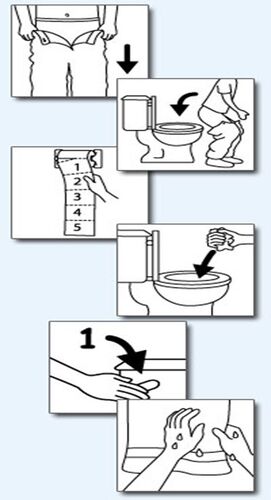Toilet training with your autistic child
When should I start?
- Choose a time when you have few engagements and are relatively stress free
- Ideally, everyone working with your child should start toilet training at the same time and follow your agreed approach.
- The first sign that a child might be ready to start toilet training is when they start to become aware of needing to go to the toilet. This may be displayed by changes in behaviour patterns, appearing distracted or fidgeting when they are wet or have soiled or they may inform when they need changing.
- It is rare for a child with autism to have the social motivation to want to be like mummy/daddy/friend and use the toilet. Your child might not see the point in changing to use the toilet after using nappies for a number of years.
What should I do?
- When changing your child's nappy, do this where the toilet is so they can start relating toileting activities to the bathroom.
- Observe your child over a few days or a week to see when they do a wee or a poo. It is quite usual for a fairly regular pattern to emerge, especially if mealtimes and drinks are provided at about the same time every day.
- Identifying the times can help to establish when to take your child to the toilet with an increased likelihood of them doing a wee or poo leading to positive reinforcement.
- Autistic children like routine, build upon this. Keep sequence of behaviours, e.g. wiping, hand washing, the same each time
- Use visual to reinforce understanding (see below)
- Change can be very difficult for children with autism so therefore it is often easier not to use a potty as part of toilet training to avoid another change from potty to toilet
- Show your child a photo or drawing of the toilet and say 'your child's name, toilet', take them into the toilet, follow your visual sequence (see below) for undressing and sit your child on the toilet. Even if they do not open their bowel or bladder, continue to follow the visual sequence as if they had.
Tip 1: Goal Setting
- Be clear about what you want your child to do
- Create a series of small goals for your child to achieve, for example:
- My child will let me know they need to go to the toilet with a word or picture.
- My child will be able to pull up their pants.
- My child will be able to sit on the toilet for 30 seconds.
- Reward child when they do an action you are teaching. Ignore negative behaviours.
- This will help move your child closer to the end goal of: Being able to use the toilet without help.
Tip 2: The toilet area
- The toilet area needs to be a nice place where your child feels safe, relaxed and happy to go.
- Use the same toilet each time if your house has more than one.
- Set this toilet up with the equipment your child needs; spare pants, toilet seat, special toy etc.
- Consider the sensory issues:
- Noise: from toilet flushing
- Touch: cold toilet seat, toilet paper
- Smell: soaps, sprays etc
Tip 3: Sitting for a wee but nothing happens
- Your child may be happy to sit on the toilet but does not wee into the toilet. Soon after getting off the toilet they wet their pants. This may happens because:
- Toilet times don’t match their pattern
- Inconsistent toileting routine
- May not understand the feeling of needing to do a wee
- What you can try:
- Keep a toileting record to identify your child’s pattern, and adjust the toilet times to match these times.
- Plan toilet times after meals, sleep or exercises
- Give your child a big drink 10 minutes before toilet time to increase likelihood of your child doing a wee
Tip 4: Won’t sit for a poo
- Your child may be happy to sit on the toilet to do a wee but refuse to sit and do a poo
- Why this might be happening:
- They may have a poor understanding of what they need to do in the toilet
- They may be anxious to sit on the toilet
- They may be constipated
- Have learnt to poo standing and do not know how to poo in the toilet
- Moving away from the poo nappy; plan and rules
- Set limits to where your child can use nappy for poo e.g., only in the bedroom
- Gradually limit its use to the toilet
- Remove nappy when they are finished and encourage them to help clean up as much as possible.
- Encourage them to empty the poo into the toilet because that is where poo goes
Tip 5: Not moving forward
- Your child has made great progress, then suddenly it all stops!! Instead of moving forwards they are moving backwards, known as regression
- Reasons for regression:
- Rewards for keeping dry may have been removed too quickly
- Accidents with wee and poos are getting a lot of attention
- Change in family routine e.g., new baby, moving house etc.
- Child may be constipated or unwell e.g., UTI.
- Solutions:
- Check your child’s health for infection or constipation
- Re-establish daily routine for taking child to toilet, using visuals and immediate praise and rewards.
- Use toilet record to establish how many accidents are occurring
- If family routine has changed, slow down your toileting expectations.
